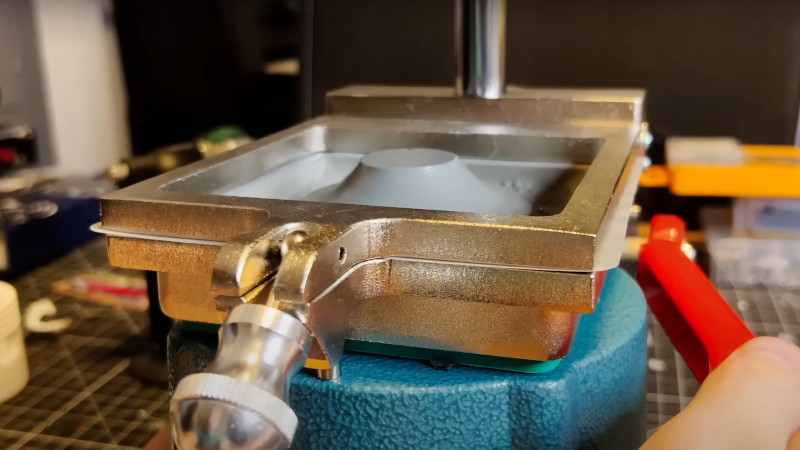Vacuum forming is perhaps one of the less popular tools in the modern maker arsenal, something which surprises us a bit because it offers many possibilities. We’ve created our own vacuum forms on 3D printed moulds for ages, so it’s interesting to see [Pisces Printing] following the same path. But what you might not realize at first is that the vacuum forming sheets themselves are also 3D printed.
The full video is below the break, and in it he details making a mould from PETG, and in particular designing it for easy release. The part he’s making is a belt guard for a table top lathe, and the PETG sheet he’s forming it from is also 3D printed. He makes the point that it’s by no means perfect, for example he shows us a bit of layer separation, but it seems promising enough for further experimentation. His vacuum forming setup seems particularly small, which looks as though it makes the job of making a sheet somewhat simpler.
The cost of a vacuum forming sheet of whichever polymer is hardly high, so we can’t see this technique making sense for everyday use. But as we’ve seen in previous experiments, the printed sheets so make it easy to add color and texture to the final product, which obviously adds some value to the technique.
Thanks [Tomas Harvie Mudrunka] for the tip.
















Surprising indeed, I just saved a vacuum cleaner from the trash the other day so that I can soon add that tool to my collection.
My wife has one of these mason jar vacuum sealers.
https://tinyurl.com/yj6r94ff
They pull a really strong vacuum and could pretty easily be used for something like this.
Maybe for small volume. We have a FoodSaver brand unit and it does pull a strong vacuum, but the small displacement of the pump means it takes a while to vacuum down a mostly empty jar. (We have a 1/2 gallon jar that we use to vacuum marinate meat because I’m too cheap to buy the dedicated function unit.)
I linked elsewhere in this comment section to a 1960’s toy vacuum former that we had when I was a kid. It has occurred to me more than once to make a version of the toy as an add-on/attachment for the FoodSaver :-)
The “real” vacuum formers I’ve seen use a turbine (like a vacuum cleaner) to draw down. I wonder if there are two stage units that use a turbine to evacuate a lot of the air then finish with a piston pump.
I’ve been vacuum forming since 1960. A vacuum former can be easily constructed at a very low price from materials that can be locally sourced. The machines may look primitive, but you can quickly get spectacular results with with even simple wooden moulds.
If you are not familiar with DIY Vacuum Forming check out some of these links.
An internet search will find many more.
Adam Savage’s Guide to Vacuum Forming
https://www.youtube.com/watch?v=lTy8tsZzT_Q&list=PLOWg-NXBoppsVCwKEGbDZP-HUnpe7fkxJ&index=1
https://www.youtube.com/watch?v=Cacr1WeKOzY
Building a Small Format Vacuumformer From an Old Toaster Oven
https://www.instructables.com/Building-a-Small-Format-Vacuumformer-from-an-Old-T/
Vacuum Former at Home
https://www.instructables.com/Vacuum-Former-at-Home/
Easy DIY Vacuum Former
https://www.instructables.com/Easy-DIY-Vacuum-Former/
Charming
https://m.youtube.com/watch?v=IO_OR0WuB4Y
As it turns out, there are DIY Mach V wind
tunnels out there. I wonder if you could combine this with vacu-forming
https://m.youtube.com/watch?v=m0ScVG0Y6t4&t=49s&pp=ygUlYnVpbGRpbmcgYSBtYWNoIDQgd2luZCB0dW5uZWwgYXQgaG9tZQ%3D%3D
Hmm, what about making the sheets by melting/pressing waste plastic? Seems like a good use for it.
This is a fantastic idea and likely far more accessible and even practical (cost wise) than trying to turn it back into filament.
The other thought I was having about this is if you really want colored sheets, why not either dye a standard thermoforming sheet, or dye sublimate onto one (can get tricky with glass and melt temps, but can be done). If you wanted the inside of whatever you’re thermal forming to be colored (or if it was transparent or maybe translucent white) you could possibly even do your transfer using the molding process itself (vacuum dye sublimation is, afterall, a thing).
… sigh, I really need to get around to building a vacuum forming table.
Right? I experimented some with hand heat forming PVC sheets at one point, but man do I want a vacuum form table and yet lack the time, space and real need to have one. Even with a standing request from my wife to build her a robot.
Hello. I’ve looked into doing this before. But the issue you run into is the sheet is not uniform, and remelting plastic makes it weaker. The plastic needs to be thoroughly cleaned and most bottles and such are made from PET instead of PETG, PET still works but it’s weaker
The size of this set up is driven by it using a dental vacuum former. Good cost vs being able to buy it ready made.
When I was a kid we had to use our toys to make our own toys.
Mattel’s Vac-U-Form:
https://www.youtube.com/watch?v=7AP8RMTZBt4
Love the idea of printing the thermoform sheets. I have this exact forming tool and sheets for it are pricey and limited in colors and material. this gets around that. Great Job!
Good layout for a smaller scale operation and agree that using PET would be more of a nuisance to work with.